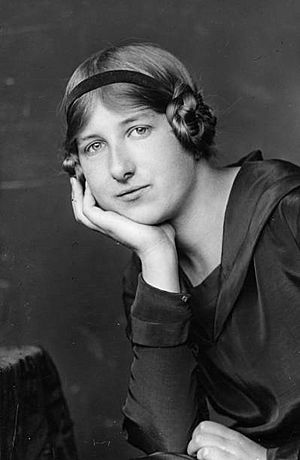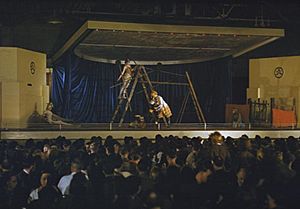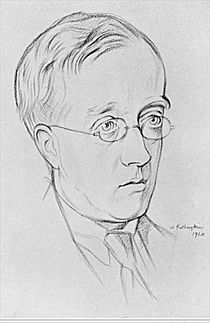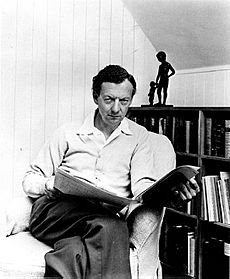Imogen Holst facts for kids
Quick facts for kids
Imogen Holst
|
|
|---|---|

photographed by George C. Beresford in 1926
|
|
| Born |
Imogen Clare von Holst
12 April 1907 |
| Died | 9 March 1984 (aged 76) |
| Education | St Paul's Girls' School |
| Occupation | Composer, arranger, conductor, teacher, musicologist, festival administrator |
| Parent(s) | Gustav Holst Isobel Harrison |
Imogen Clare Holst (born 12 April 1907 – died 9 March 1984) was a British musician. She was a composer, arranger, conductor, teacher, and music expert. She also helped run music festivals.
Imogen was the only child of the famous composer Gustav Holst. She is well-known for her teaching work at Dartington Hall in the 1940s. She also spent 20 years as a director of the Aldeburgh Festival. Besides writing music, she wrote books about composers. She also created many educational materials. Several of her books were about her father's life and music.
From a young age, Imogen showed great talent in music. She composed and performed well. After attending Eothen School and St Paul's Girls' School, she went to the Royal College of Music. There, she became a skilled conductor and won awards for her compositions. Imogen wanted to be a pianist or a dancer. However, health issues prevented her from doing so.
In the 1930s, Holst mostly taught music. She also worked full-time for the English Folk Dance and Song Society. These jobs meant she composed less of her own music. But she made many arrangements of folk songs. During World War II, she worked for the Council for the Encouragement of Music and the Arts. In 1942, she started working at Dartington Hall. In nine years there, she made Dartington a major music education center.
In the early 1950s, Holst became Benjamin Britten's music assistant. She moved to Aldeburgh and helped with the yearly Aldeburgh Festival. In 1956, she became a joint artistic director of the festival. For the next 20 years, she helped it become very important in British music. In 1964, she stopped working as Britten's assistant. She wanted to focus on her own composing. She also worked to preserve her father's musical legacy.
Imogen Holst's own music is not widely known. Much of it has not been published or performed often. However, the first recordings of her works came out in 2009 and 2012. Critics liked these recordings very much. She received the CBE award in 1975. She also earned many university honors. Imogen Holst died in Aldeburgh and is buried there.
Contents
Early Life and Family
Imogen Holst was born on 12 April 1907. Her birthplace was Richmond, a town near London. Her parents were Gustav Theodore Holst and Isobel Harrison. Gustav was a music teacher and a composer. The Holst family had been musicians for many generations.
Gustav Holst taught music to support his family. He taught at James Allen's Girls' School and St Paul's Girls' School. He was also the music director at Morley College. When Imogen was very young, her family moved to Barnes. She remembered her father working in his composing room. She was not allowed to go in there. She also remembered him teaching her folk songs.
Schooling and Early Music
Imogen was described as having blue eyes and fair hair. In 1912, at age five, she started kindergarten at the Froebel Institute. She stayed there for five years. Summers were often spent at the family's cottage in Thaxted. Her father started a music festival there in 1916.
In 1917, Imogen began boarding at Eothen School. Her father's student, Jane Joseph, taught music there. Imogen studied piano, violin, and music theory. Under Jane Joseph's guidance, Imogen wrote her first compositions. These included instrumental pieces and Christmas carol tunes. In 1920, she composed and choreographed a "Dance of the Nymphs and Shepherds." It was performed at the school under her direction.
Imogen left Eothen in December 1920. She hoped to study dance, but was not accepted due to health reasons. She then studied at home with a governess. In 1921, she danced in her father's production of Purcell's Masque of Dioclesian.
In September 1921, Imogen started at St Paul's Girls' School. She became a boarder in 1922. She performed a Bach piece on the piano, which was praised. Imogen enjoyed her time at St Paul's. In 1923, she won a piano prize. However, her chances as a pianist were affected by a problem with her left arm. She became interested in folk music and dance. In 1923, she joined the English Folk Dance and Song Society. In her last year at St Paul's, she started a folk dance group at the school.
Royal College of Music
Imogen went to the Royal College of Music (RCM) in September 1926. She studied piano, composition, and conducting. Her talent as a conductor was clear early on. She led the college's Third Orchestra in a Mozart symphony. People thought she might become the first woman to be a famous conductor.
In her second year at RCM, she focused on composing. She wrote several chamber music pieces. She also moved out of her family home to live independently. In 1928, she traveled to Belgium and Germany. She won the RCM's Cobbett prize for her Phantasy String Quartet. This piece was even broadcast by the BBC. In 1929, she visited Canada and the United States. She worked on her final RCM composition, The Unfortunate Traveller, a suite for brass band. In 1930, she won a scholarship to study composition abroad.
Career Highlights
European Travels and Teaching
From September 1930 to May 1931, Imogen traveled a lot. She visited Scandinavia, Germany, Austria, and Hungary. She saw many famous operas and concerts. She also went to Italy. She felt that London was the best place for music.
After her scholarship ended, Holst needed a job. In 1931, she became the music director at Citizen House in Bath. She didn't like the strict rules there. In 1932, she joined the English Folk Dance and Song Society (EFDSS). Her main job was teaching. She also taught part-time at Eothen and Roedean School. She composed little original music during these years. However, she made many arrangements of folk melodies.
Gustav Holst's health had been poor for years. He died on 25 May 1934. Imogen decided to protect her father's musical legacy. In 1935, she conducted her own arrangement of one of her father's pieces at a memorial concert. Her own music also started to get noticed. Her carol arrangement "Nowell and Nowell" was performed in 1934. Her Concerto for Violin and Strings premiered the next year. In 1938, she published a biography of her father. Critics praised it for being honest and objective.
War Work and Dartington

In 1938, Holst decided to focus on her professional music career. She left her teaching jobs. In 1939, she toured Switzerland. When war seemed likely, she returned home.
After World War II began in 1939, Holst helped German and Austrian refugee musicians. In 1940, she became a "music traveler" for the Pilgrim Trust. Her job was to boost morale by encouraging music in rural areas. This role later moved to the Council for the Encouragement of Music and the Arts (CEMA).
Holst's organizing skills grew during this time. She conducted local brass bands and choirs. She also organized sing-alongs for children who had been moved away from cities. She arranged performances by professional groups. She wrote about the joy of discussing music with people. Her own composing was limited by her busy schedule. But she wrote two recorder trios and many arrangements for female voices.
In 1941–42, Holst was invited to work at Dartington Hall. This was a progressive school and arts community in Devon. In 1942, she left CEMA to work there full-time. She started a one-year music course in 1943. It trained young women to organize music events. The course grew to offer general music education. Under Holst, Dartington became a center for music. She formed an amateur orchestra, even though most members were beginners. Her teaching style focused on "learning by doing." This approach was very successful.
At Dartington, Holst started composing seriously again. In 1943, she wrote a Serenade for flute, viola, and bassoon. She also composed a Suite for String Orchestra and a choral work, Three Psalms. These works were performed at a concert dedicated to her music. Other pieces from this time included a String Trio and an oboe concerto. In 1943, the composer Benjamin Britten and tenor Peter Pears performed at Dartington. Holst and Britten became good friends. They both loved old music from the Renaissance and Baroque periods.
From 1945, Holst expanded her musical activities. She edited music for Britten. She also helped promote Dartington as a base for Britten's new English Opera Group. In 1947, she helped the violinist Norbert Brainin form his own string quartet. This group later became the famous Amadeus Quartet. In 1948, she began writing a book about her father's music. It was published in 1951.
Holst's high standards at Dartington allowed for more challenging performances. In 1950, she organized Bach's Mass in B minor. This took three years to prepare. By 1950, Holst's focus was changing. She had attended the first two Aldeburgh Festivals. In 1950, she was asked to write a choral work for the 1951 festival. She decided to leave Dartington. She spent some time studying Indian music in West Bengal. Her one-act opera, Benedick and Beatrice, was performed at Dartington to mark her departure.
Aldeburgh Festival Leadership
After Dartington, Holst traveled in Europe. She collected old music to edit for performance. She also worked with Britten on projects. These included a new version of Purcell's Dido and Aeneas. She also helped prepare music for Britten's opera Billy Budd. Peter Pears believed Holst could help Britten and the Aldeburgh Festival. In 1952, Britten invited her to work with him. She agreed and moved to Aldeburgh.
Assistant to Britten
When Holst joined Britten, their financial arrangement was not clear. Britten paid her for each task. Holst had given her father's estate to her mother, so she had little money. She lived simply in Aldeburgh. But her dedication to Britten was most important. For 12 years, her life focused on helping Britten and the Aldeburgh Festival. She also made many music arrangements. She promoted her father's music and wrote books and articles.
Holst kept a diary for her first 18 months with Britten. It showed her strong belief in Britten's work. One of Britten's first works she helped with was the opera Gloriana. It was for the 1953 Coronation celebrations. Holst's main job was to copy Britten's sketches. She prepared the music for singers to rehearse. She also helped with his next opera, The Turn of the Screw (1954). When Britten was busy composing his ballet The Prince of the Pagodas (1956), Holst went with him to Switzerland. She stayed by his side until he finished the work. She enjoyed working on Britten's children's opera, Noye's Fludde (1957). She showed him how to make a raindrop sound by hitting china mugs. They also worked together to publish music for the recorder. They co-wrote a book, The Story of Music (1958).
Holst continued to help Britten with all his major compositions until 1964. Then, she decided to focus on her father's music. She also wanted to restart her own composing career. She left her job as Britten's assistant but remained devoted to him. She stayed in Aldeburgh and continued her work with the festival.
Artistic Director
In 1956, Holst's role at the Aldeburgh Festival became official. She joined Britten and Pears as an artistic director. She was in charge of programs and performers. For the 1956 festival, she scheduled her father's opera Savitri. This was the first of several of Gustav Holst's works she brought to the festival. She also arranged John Blow's 17th-century opera Venus and Adonis. In 1957, she started late-night concerts. In 1962, she organized a series on Flemish music. She also planned many church music programs.
Since moving to Aldeburgh in 1952, Holst had lived in rented places. In 1962, she moved into a small bungalow built for her. This house was where she lived for the rest of her life.
In 1964, Holst started composing again. In 1965, she took on two big commissions. These were The Sun's Journey, a cantata, and the Trianon Suite. Between 1966 and 1970, Holst recorded many of her father's works. She conducted the Double Violin Concerto herself. Forty years earlier, she had been the rehearsal pianist for its first performance.
Holst formed the Purcell Singers, a small choir, in 1952. The choir performed regularly at the Aldeburgh Festival. Their programs included old medieval music and new 20th-century works. Many choir members later became famous musicians. In 1967, she stopped conducting the choir.
On 2 June 1967, Holst and Britten conducted the first concert at the Aldeburgh Festival's new home, the Snape Maltings. From 1972, Holst helped develop educational classes at the Maltings. These grew into the Britten-Pears School for Advanced Musical Studies. By this time, Imogen performed less often at the festival. But in 1975, she conducted a concert of Gustav Holst's brass band music.
Britten's health was poor after heart surgery in 1973. He died on 4 December 1976. Holst was unsure if she could continue working with Pears alone. In 1977, at age 70, she decided to retire as artistic director after that year's festival. She made her final festival appearance as a performer. She filled in for another conductor at a concert. Upon retiring, she became an honorary Artistic Director Emeritus.
Later Career and Death
Gustav Holst's 100th birthday was celebrated in 1974. Imogen published a catalog of his music. She also founded the Holst Birthplace Museum in Cheltenham. She worked on publishing her father's original music manuscripts. She also helped arrange exhibitions about his life and works.
Besides books about her father, Holst continued to write about music. She published a study of the composer William Byrd (1972). She also wrote a handbook for conductors of amateur choirs (1973). She continued to compose, mostly short pieces. But she also wrote larger orchestral works like the Woodbridge Suite (1970). Her last major composition was a String Quintet in 1982.
In April 1979, Holst was present when the Queen Mother opened the new Britten–Pears School building. This building included the Gustav Holst Library. Holst had donated many books and materials to it. She had planned to fully retire after 1977. But in 1980, she organized a 70th birthday concert for Pears.
Death
After the 1977 Aldeburgh Festival, Holst became seriously ill with heart problems. This was a recurring issue. However, she continued to work. By early 1984, her health was clearly getting worse. She died at home from heart failure on 9 March 1984. She was buried in Aldeburgh churchyard, near Britten. An obituary praised her dedication to music.
In 2007, Holst's 100th birthday was celebrated at Aldeburgh. There were special events, including a concert of her music. Her String Quintet was described as "genuinely memorable."
Holst never married. She had some close friendships. She once told Britten that she would have married a poet named Miles Tomalin.
Honors
Holst became a Fellow of the Royal College of Music in 1966. She received honorary doctorates from several universities. These included Essex (1968), Exeter (1969), and Leeds (1983). She also became an honorary member of the Royal Academy of Music in 1970. Holst was appointed a Commander of the Order of the British Empire (CBE) in 1975 for her services to music.
Her Music
Imogen Holst composed music in between her many other musical activities. In her younger years, her music was often performed and broadcast. Her Mass in A minor (1927) showed her skill in layering voices. However, for long periods, Holst composed very little. Her most active composing years were at Dartington in the 1940s and after 1964.
Her music includes pieces for instruments, voices, orchestras, and choirs. Holst was influenced by her father and her love of folk songs. Some of her early works show the pastoral style of Ralph Vaughan Williams, who taught her. In the 1930s, she was known for her folk song arrangements.
Her personal style developed in the 1940s. It combined folk song, dance, and old English music. She also liked to experiment. In her 1930 viola suite, she tried new scale patterns. By the 1940s, she used her own six- and eight-note scales in her chamber and choral music. This experimentation continued in later works. For example, in Hallo My Fancy (1972), a new scale is used for each verse. Her String Quintet of 1982, which she felt made her "a real composer," is known for its warm harmonies.
Much of Holst's choral music was written for amateur groups. Critics have noted a difference in quality between these and her works for professional choirs. Her pieces for women's voices are considered some of her best original compositions.
Record companies were slow to recognize her music. In 2009, the first CD dedicated entirely to her music was released. It featured her works for strings. A reviewer for The Guardian welcomed it, saying much less valuable English music is often praised. In 2012, a selection of her choral music was recorded. One review called Welcome Joy and Welcome Sorrow an "insight into her own, softly nuanced, pioneering voice."
Published Books
- Gustav Holst: A Biography (1938, revised 1969)
- The Music of Gustav Holst (1951, revised 1968 and 1985)
- The Book of the Dolmetsch Descant Recorder (1957)
- The Story of Music (1958, co-author with Benjamin Britten)
- Tune (1961)
- An ABC of Music (1963)
- Bach (1965)
- Britten (1966)
- Byrd (1972)
- Conducting an Amateur Orchestra (1973)
- A Thematic Catalogue of Gustav Holst's Music (1974)
- Portrait of Gustav Holst (1978, co-editor with Ursula Vaughan Williams)
- The Britten Book (1981, editor)
- Gustav Holst: Collected Facsimile Edition of Autograph Manuscripts of the Published Works (1974–83, editor)
- The Great Composers: Holst (second edition 1981)
Imogen Holst also wrote many articles, essays, and program notes.
See also
 In Spanish: Imogen Holst para niños
In Spanish: Imogen Holst para niños






